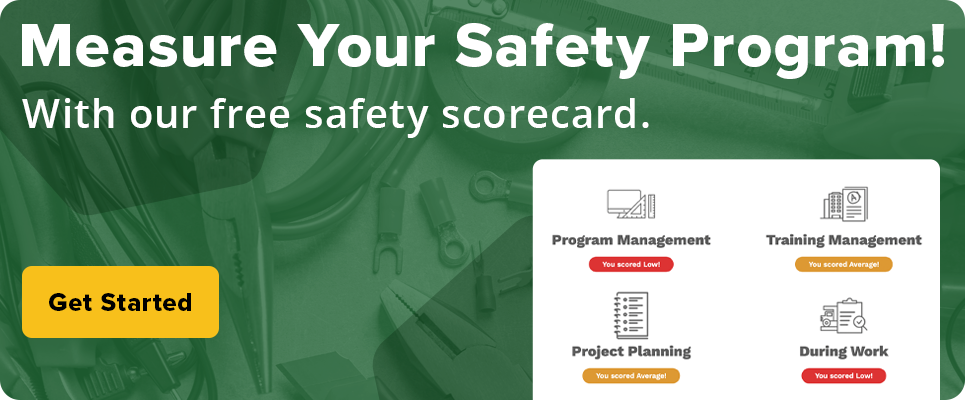
Updated May 10th, 2024
Making the case for safety software or other technology investments can be a tough subject – especially if your work can continue without spending that money. It’s one of the big reasons why the construction industry lags behind others in adopting new technologies.

Some who have sought to improve efficiency through technology have faced an uphill battle with upper management & ownership. This helpful guide will provide you with advice to make those conversations go more smoothly and ultimately in the company’s favor.
To land the technology you know your company will benefit from, you’ll need a solid case that outlines why the investment is necessary. In addition to creating safer jobsites, there are several additional benefits you should mention to convince the C-suite to move forward.

4 (+ 2 New Bonuses) Ways an Investment in Safety Technology Benefits Your Business:
Good news: Investments in technology to improve safety can actually impact departments that span far beyond safety itself. Pointing out potential company-wide improvements can help justify the cost of safety technology to leadership.
1. Increased Sales
The bad publicity alone from a workplace injury can be enough to negatively impact work.
Certain general contractors, industrial sites, healthcare organizations, and educational institutions simply won’t work with companies that have poor safety numbers – such as your total recordable incident rate, your experience modification rate, OSHA citations or lost-time incidents – due to the inherent risks involved. They want to hire and work with safe contractors, so they don’t have to worry about delays, downtime, injuries or potential lawsuits.
If you can demonstrate how your technology investment will make it easier for employees to get on board with safety culture, policies and procedures, then you can also explain that the investment may also pay off in more work due to better safety numbers. Safety is a sales differentiator!
2. Streamlined Finance and Accounting
There are many ways that an investment in technology for safety can make life easier for your accounting team.
To demonstrate the impact your investment may have for this group, provide a few real-world examples of common jobsite injuries and their associated costs. There are plenty of illustrations to choose from (we can provide data that may help, too).
Don’t forget to quantify all related expenses, from production losses and wages for work not performed to damaged equipment and increased insurance costs. Then compare those numbers to the cost of your technology investment. Everyone will quickly be able to see that the cost of technology to improve safety is much lower than the cost of an injury – which is often the result of an unsafe work environment.
Be sure to share information with the accounting team about other potential financial savings that can result from a technology investment as well, including the avoidance of OSHA penalties and a reduction in general liability insurance, workers’ compensation insurance, and medical costs.
The right technology can also eliminate the paperwork shuffle for the accounting department, allowing employees in the field to send things like timesheets, packing slips, receipts, and status reports electronically so no one has to track and file hard copies or make sure they get back to the office.
3. Smooth Operations
Being safe on the job site isn’t a productivity bottleneck. In fact, it can have quite the opposite effect. Investing in technology that helps your organization take a holistic approach to safety actually leads to higher worker productivity. Why? Because time and money aren’t lost due to injury or work restrictions.
Workers who are afraid of getting hurt may produce less as they attempt to avoid potential hazards. Employees are more productive when they work on jobsites they trust to be safe – they don’t have to worry about avoiding certain tasks or areas.
An investment in technology for safety can help field staff be more confident about installation practices and the tools and equipment they use. Technology that puts this information in the palms of their hands means they don’t have to waste time searching for answers to questions, discussing with others, or waiting for callbacks from a safety director. This keeps projects moving forward as planned.
The right technology can also speed up the approval process for things like energized work reports or change orders. When an employee in the field can complete forms electronically, document their plan, and submit everything electronically for authorization, work continues without delays or holdups in the approval process.
4. Reduced Employee Turnover
Recruiting and retaining top talent are easier for organizations that care for employee well-being and provide safe workplaces. A strong focus on and investment in safety demonstrates to employees their importance and value, which can reduce employee turnover and absenteeism.
When employees know that their own protection comes first, they’ll feel more loyal and be less likely to look elsewhere for work. After all, who wouldn’t want to work for a company that makes investments to improve safety and protect employees?
5. Stronger Safety Culture
Companies that establish a strong safety culture develop employees who are actively aware and engaged with safety procedures, which creates a more productive workplace with less incidents. One way to start building a strong safety culture is with construction safety technology.
Construction safety technology keeps employees, their supervisors and company executives on the same page when it comes to safety. With construction safety technology, a strong safety culture is more than just speeches or words on a company’s website because safety initiatives can be created, distributed and tracked all from one software. A few examples include Toolbox Talks, job-specific training, job hazard assessments (JHAs) and incident reporting. Additionally, companies can compile their safety data to determine key performance indicators, such as total recordable incident rate (TRIR).
Improving company-wide safety procedures creates an environment where employees feel safer on the jobsite, allowing them to focus more on completing their task instead of worrying about unaddressed safety concerns. Ultimately, this leads to less incidents and increased production, which can snowball into good public relations for the company and attract more profitable project opportunities and talented candidates for job openings.
6. Limited Company Risks
Common company risks related to safety are lawsuits involving personal injury or property damage and OSHA fines and penalties for not submitting the proper incident documentation or following safety procedures. Construction safety technology can identify, mitigate or even help remove these risks with its JHAs, distribution and tracking of Toolbox Talks and digital incident reporting system.
Additionally, construction safety technology can be used as an ongoing educational tool. Your company can easily assess past projects — what procedures worked well and areas for improvement — and adjust its approach accordingly. Construction safety technology’s ability to help limit risks provides peace of mind to company executives, allowing them to focus more of their time on growing the business.

The Return on Investment
Safety management systems like SafetyHQ lower incident rates, and lower incident rates lead to reductions in your workers’ compensation and insurance premiums. We’re dedicated to the safety of your workers just as much as you are!
Share Article
Keep on current news in the construction industry. Subscribe to free eNews!

